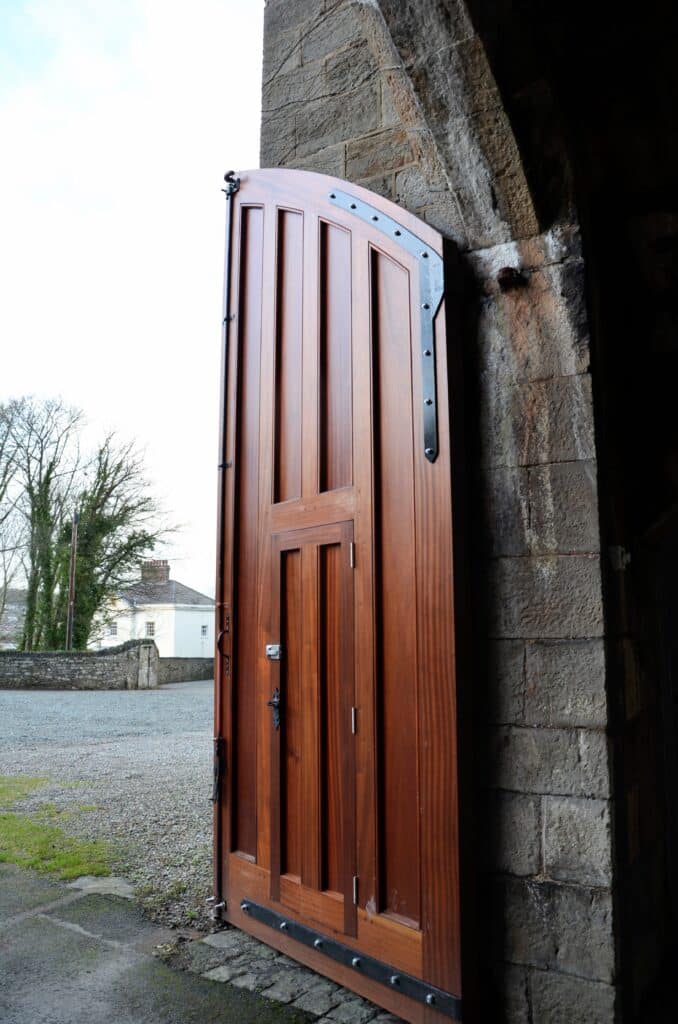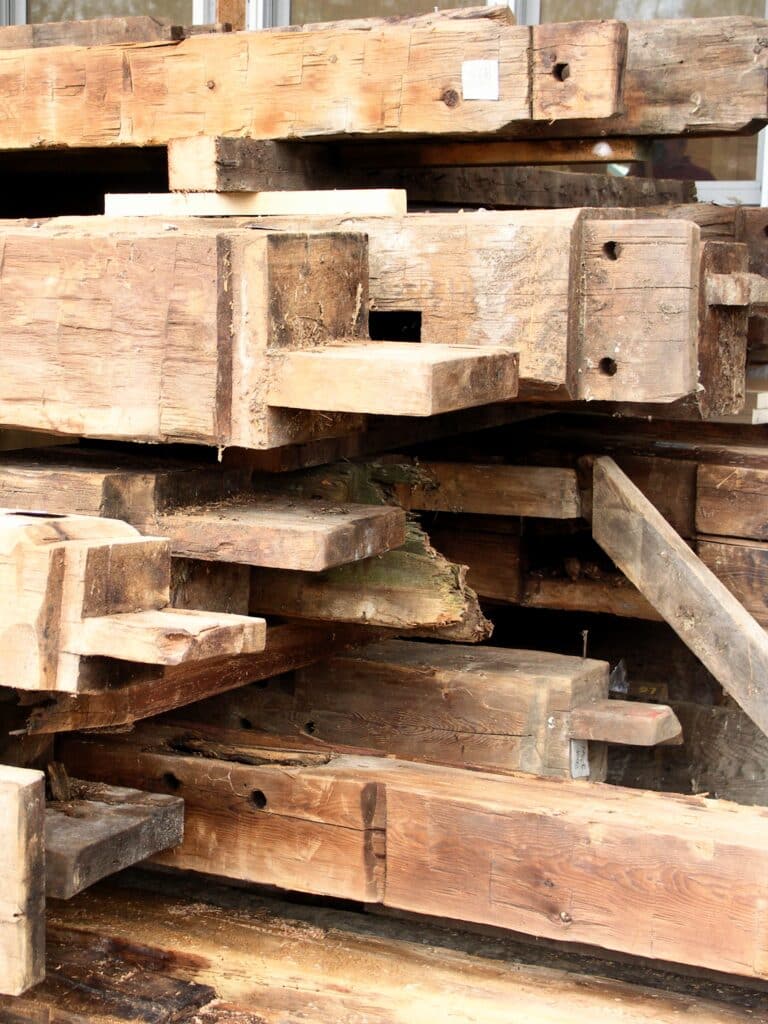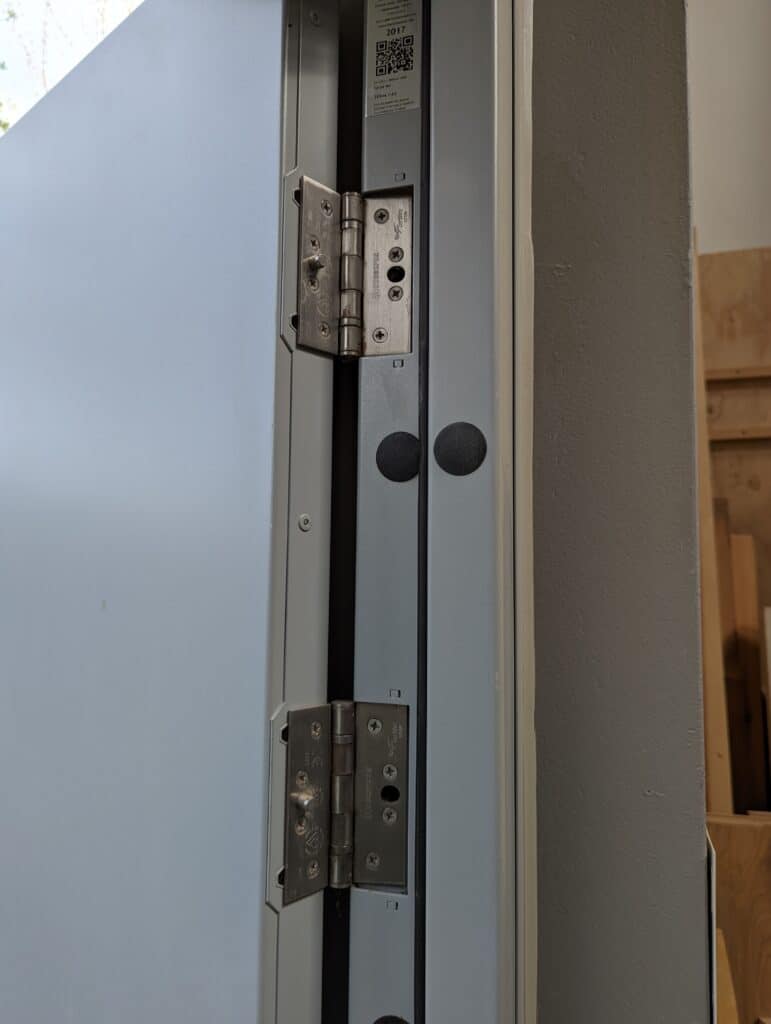Hanging Around
More on hinges. Those things that just hang in open space to fill a space and keep out the enemies of life and let friends in and out as desired yet something that is so taken for granted. Everyone pretty much ignores gates and doors except the man that makes them, fits them and hangs them in space with an expectancy for them to stay hung so for a hundred years or two.

Considering the physics surrounding hinges and doors, questions arise around where to position them and this is mostly determined by the rails in relation to the stiles. Even modern doors still rely on mortise and tenon joints to the corners and rails and some of the larger, longest and deepest mortise and tenons we use today surround door making because the tenons extend into the mortise holes for maximising stability in something that literally just hangs within a space and that is fixed only on points along one side; this is especially so if we indeed dismiss timber-framed structures like vintage barns. On these buildings, I’ve seen them 21″ wide, 1 1/2″ thick and 10″ long.

Most of us don’t really think to consider what’s taking place at the various hinge positionings in relation to the corner joints of doors, sashes and lids and gates Hinges need to be close to but not into the joint area if possible. It is common to site the top edge of the hinge and resulting recess level with the underside of the top rail and the bottom edge of the bottom hinge level with the top edge of the bottom rail. This avoids screws being driven into end grain which has less holding power. Middle hinges either get placed centred between these two or nearer as an offset towards the top hinge. This is of course relating to side-hung doors, framers, sashes and panels. For top-hung sashes and such, this positioning is a little more variable, but, mostly, hinges are placed near to or directly adjacent to the joint to minimise any distortion caused by weight to the stiles and rails; the more direct the linkage the less flex and movement there will be.

Taking time out to think about the hinges, you soon begin to see that the door more ‘hangs’ from the top hinge with the natural tendency to pull very directly away from the doorframe. On the other hand, the door hinge at the bottom of the door never pulls away but actually spends all of its time heavily sandwiched under weight pressure so that all of the wood and the hinge remain firmly under direct and opposite pressure direction to the top hinge. The top of the door, whether closed or open, takes the greatest amount of strain, many thousands of tons throughout a lifetime. That’s why, on commercial doors, you often see two hinges a few inches apart to take the pull-strain of the added top weight and then a mid-placed hinge as well as the bottom hinge.

Fire doors may be required by law to have three hinges on certain buildings here in the UK; for a house, it might be if the building has more than two levels. On commercial buildings, it might be that every door must have three hinges, partly because of the weight and then because of the added resistance three hinges gives. This positioning of the two top hinges works in the same way twin rails are used in chair construction close to one another — it’s about transferring weight. Effectively they extend a tenon shoulder from say 2″ to become the equivalent of say a 6″ one, depending on how far apart they are placed. We do the same with rails to doors, to distribute weight and transfer pressure points. Door bracing transfers top outer weight to the inside bottom-weight at the bottom hinge. A brace placed as a diagonal this way serves as a permanent stop or check to stop drop at this extreme point in the door or frame.

A wonderful example of weight transfer is the English field gate that relies on a fixed top pintel only and then the weight of the gate against the bottom ones twinned to allow the gate to open and close in either direction and used mostly for allowing horse riders to pass through whilst remaining mounted.



Uh, what is “twinning” please?
I believe it means parallel and matched.
Thank you, John. So I guess you mean like a “double hinge” sort of device? I’m having trouble picturing it.
A very timely discussion about doors and hinges.
I am making a 6 panel pass through door for a recently remodeled room in our house.
The previous door was a hollow core birch door, very lightweight with only two hinges.
Some time ago when adding on to the house I installed 6 panel doors in the new part of the addition. After 15 years of use the doors started sticking and binding. Upon inspection I found the doors were separating at the joints, they were made with stub tenons and dowels. To fix them I counterbored holes in all the tenon joints and drove 3” screws and worked glue into the separated joints. Not the best option but they seem to be holding up.
The price of a new door with the same construction is over $400, you just can’t get a commercial door that’s built with a full mortise and tenon. Building my own door is not any cheaper but at least it will last for my lifetime when I’m done making it. I plan to use three hinges because of the added weight and reading your explanations.
– 1 Interesting discussion about bracing on the site of the late Chris Hall.
Google “the carpentry way a bracing situation” (four consecutive blog post)
-2 “It is common to site the top edge of the hinge and resulting recess level with the underside of the top rail and the bottom edge of the bottom hinge level with the top edge of the bottom rail. This avoids screws being driven into end grain which has less holding power. ” Aha. I didn’t read this explanation in the Lost art press blog. I thought it was for aesthetic reason.
– 3 An interesting door design:
Bracing inherent of design and sliding dovetails with tapered batten.
Google: “GUPEA Borddør med inngradet labank – dragspondør” and then click on the PDF link.
It is in a Nordic language (I don’t speak any of them) but the pictures and drawing are clear enough.
Trick page 34: the fence serves also as depth stop against the metal rule to ensure a straight dovetail.
I’ve always worked on 6″ from top of door and 9″ from bottom.
That is to nearest edge of hinge and mid span for third.
John 2V
That was standard on flush doors since the 1960’s
Sylvain, that’s a very interesting paper on the old Swedish doors, thanks for posting. I really like the idea of the tapered sliding dovetail. However, I did something very similar to this recently. I was making a board for my daughter to do her jigsaw puzzles on (so she can sit on the carpet). It consisted of four 150mm wide oak boards, approximately 1m in length. They were maybe 12-15mm thick. I created three sliding dovetails to join the four boards together, which I tongue and grooved for alignment purposes mainly. It looked great, and fitted very tightly. However, after a couple of weeks in my centrally heated house (away from my not so centrally heated garage!), the tapered batons shrank in the housing and became a lot less tight! This results in me having to push the boards together when I pick it up. It’s not a big deal, and I actually wanted the ability to take apart for different storage options anyway (although it fits perfectly under my sofa when assembled). Going back to the article you posted then, I’m surprised that there has been no similar movement in any of the sliding tapered joints in all the examples. None appear to be in buildings that would have been “upgraded” to modern insulation standards, so perhaps the moisture levels have just remained consistent over time. Perhaps it’s the horizontal positioning of the batons, I don’t know. It does remind me of some Korean joinery (and similar Chinese) which had similar tapered sliding dovetails holding boards together, but at the tapered end the baton sat proud of the panel. Around the entire panel, there was a frame, which effectively “hooked” into the proud end of the baton, forming a wedge that pulled the sliding taper baton through, locking it in place. It was quite impressive. I was thinking of replicating with just a couple of wedges for my puzzle board. Anyway, a fantastic read, thanks.
The paper is written as a student essay/thesis paper for a student doing a Bachelors degree at Gothenburg University, Dept of Conservation, but the doors are Norwegian and the paper is written in Norwegian and not Swedish as I suspect that the author is a Norwegian. The language is similar to Swedish and I’m able to read most of it but there are many words and expressions that are different enough to make it slow reading and with some hard to understand passages.
Then of course there are some parts that are hard to understand as words and expressions are very technical to their nature and not part of the “common” language.
Good read though and very interesting. I wonder why they didn’t have the wedge shape in the other direction to counteract the pull of gravity on the doors boards. Maybe it wasn’t necessary?
Some of the words really shows the history and kinship of languages. The Norwegian word ‘bord’ is the same as English board and in Swedish that wold be ‘bräda’, so some changes over the centuries since the languages diverged from a common languge. A board on the side of a boat is still called ‘bord’ in Swedish so the word still exists but have taken a more specialized meaning.
I had to rebuild a pair of gates on my driveway. The “old” ones were falling apart. When I considered the construction what jumped out was the diagonal braces ran the wrong way. The weight of the gate on the hinges would tend to pull the rectangle into a parallelogram over time, loosening the joining – mainly screws. Reversing the direction of the bracing put the system into compression and the gates are now around twenty years old. The next problem with them will be finding posts to replace the original posts, which I reused. They are gradually failing.
In my area the electric company is usually happy to give away old wood telephone/electric poles just to not have to dispose of it themselves. Usually the middle portion of the pole has many years of life left.
Wow what a beautiful door.
The modern door shown has the bottom hinge, in my opinion, too close to bottom.
On a fire door, I’ve always used a double leaf hinge with a fire retardant material beneath hinge.
John2v
Would green or seasoned oak be best for gates and the like?
Oak for field gates was air-dried and seasoned for a good year or two (here in the UK) as air-dried wood before mortising for gates The main hanging stile was 3″ by 5″ whereas the free stile was a 3″ by 3″ because of weight. Top rails tapered from the hung end at 5″ to 3″ at the free end and lower rails were from 1″ thick and so too the bracings.
It’s fine to go with kiln-dried wood. You say green wood or seasoned wood but remember wood is rarely seasoned today. Mostly, the term might be seasoned but kiln-dried is not left to season as in times past where it acclimated in the air0drying process which took several years, so seasoned wood is not kiln dried wood per see but it is fine to use for outdoor use like this.
On a well-made field gate we still would use mortise and tenon joints for the main frame and thereby have shoulders to the tenons so drier is best as shrinkage away from the shoulders reduces strength and resistance at the joint lines.
Thank you Paul, very useful. I’m thinking of some garden gates in oak so presumably I can shave down on some of those dimensions?
Hi paul when hanging doors do you use a spacer to judge the “penny gap” and what tolerance would you have for the even gap say 0.5mm? or is it more of an exercise in letting your eye be your guide?
Definitely the eye. Fit the door dead tight, site and fit the hinge recesses and hang the door in its place, close the door to meet the jamb and then fit to suit. One screw in each hinge at first and before the last and final fit, put all the screws in place and cinch up tight to take out any and all play.
Thanks for that paul may i also ask in terms of your general philosophy do you have allowances or tolerances in your work? like for example the few thou difference on the hinge gap margin and as long as it looks good by eye then inconsistencies do not matter? for example i was shooting a door in the other day and i was using a sliding bevel to guage by leading edge and i thought would anyone notice? i guess what im trying to ask is do you only tolerate perfection and zero tolerance in your work? thanks
I think it’s a good question. I think it’s according to project. A garden gate and a front door have a greater tolerance for a bigger gap than an internal door and I only gauge by eye and never by measurement. That’s why I fit the door to the opening, hinge it and hang it and then close it to the adjacent jamb. This involves lifting the door on and off a couple of times. Mostly I fit the bottom of the door to fit into the opening first and have a mil or two for a gap. Then I hang and plane parallel while it is hung in place. You get used to the awkwardness of planing this way. First plane off the leading edge so that it enters the opening but just barely. One inside the opening plane at a consistent bevel until it closes against the stops or rebate. From here, plane parallel according to what you feel looks right.
Interesting thoughts Paul would you consider yourself a perfectionist when working on fine furniture? Or can you still have allowances and tolerances in your work and as long as it’s not too noticeable by eye then it’s not deemed poor workmanship? I know sensitivity and accuracy are of great importance but is there a limit where human error will always exist and perfection an illusion?
I am not sure that they are merely “interesting thoughts”, really, Marcus. That suggests that I sit and think more than act and do when in reality critical thinking takes us from one section of work to the next and sometimes its a seamless transition and others it’s a complete turnabout based on gut feeling, yes, but then equally as likely, calculation in the immediacy of events that demand immediate attention. I allow many things to pass. I notice a pencil line that wasn’t erased or a small gap as I glue down a joint. Yes, I carry on. I am not a perfectionist which most often is little more than pride or a fear of others finding something we did that is not the perfection we want to be known for and something that many live in anxiety unnecessarily just for the approval of others. To me, perhaps the pencil line and the gap show my humanity yet I remain undisturbed in knowing that people will actually see the more that it is indeed hand made. Who is the one to judge the work of a man that made a whole chair by hand? Surely it must be makers who do the same? I don’t much care for perfection because for every perfect thing there are a million that are imperfect. What I want is the organic, the vibrant, the open transparency of honest workmanship. It’s shameful that to see something of real substance hand made we have to look back to historical pieces for most of us know no one that actually makes with the sincerity of true handwork.
Sorry Paul I didn’t mean it like that apologies for that, I recently read a quote by Michelin star chef Thomas Keller “repetition is the mother of perfection” meaning if there was any “perfection” in this world then it would be to learn through doing and completing projects as perfection suggests we arrive at this so called destination when in fact it’s a process and something we may only achieve momentarily in life and is more mystery than exact science. I also would like to think you’re more of in the camp advocating learning by doing as opposed to learning through a textbook or by the words of a “guru”?
No issue Marcus. Yes, we become competent in the repeats. It’s a process. Standards are according to what we see as acceptable and we make according to fitness of purpose. I like it when it comes right off the chisel or the plane, the saw and the spokeshave. I like patience and kindness, something made with love and thoughtfulness. These things are the somethings of life.
I think as long as we use our senses to the best of our ability and really feel the sensations through the pressure you apply through say a plane with the utmost care and have good intentions in our work the rest is just practice. I think Paul means as long as we’re supple with our hands and try to be as accurate as we possibly can then that’s all one can do as we’re all human
In the pursuit of perfection,
One only finds imperfection,
Not joy.
Hi paul would you say woodworking and carpentry is learnt by doing and making mistakes? or would you suggest one should learn by using resources such as books and thinking prior to making?
We face the sad demise of a century’s displacement of adults, parents especially, in crafts and trades as a way of life. Along with that, the ability to therefore pass on the knowledge of experts via word of mouth apprenticing as in days past is all but gone. It’s true too that education successfully distanced the key role of parents training their children by failing to recognise the concept that parents are often the best resource for children to learn practical skills from parents and grandparents by dismissing craftwork like woodwork from the school curriculum. In the more recent years, we have seen other curricula introduced that seems more to distance parents from the ultimate responsibility from active participation in educating their children. Practical training by schools providing a version of what was once more a parental responsibility in nature, gardening, crafts and the arts and so on seems now to be a total responsibility of a teacher who will have no practical background or even interest in the subject matter. I have heard from many teachers who say they simply stay ahead by a day or two by reading the curriculum just before they teach it in class. That’s not to say they don’t provide a valuable resource for kids that might never have the opportunity to be out in the great outdoors on a field trip and such, just that parents should always becalled upon to be as actively involved as possible in educating their children and supervising both their child’s education and the actual teachers involved in teaching their children too. I don’t think that this is the teachers fault at all. I think it is a system that failed to develop and evolve beyond governance by politics and policy makers.
Apprenticeships have been dumbed down utterly in many realms of crafts and especially woodworking and furniture making simply because the world no longer needs skilled artisans specializing in handmade woodwork; handmade anything can never compete with mass-made goods anyway. Most items used in the home and office are hardly ever made with any hand use at all except to push buttons, load and offload and to make sure nothing jams for too long to hinder production. I see also that, in general at least, many machine products surpass handmade and the expectancy of a low price goes hand in glove with globalised consumerism. Local colleges occasionally offer degree courses for around £27,000 for a three-year degree program at the end of which you are supposedly a fully skilled maker. Of course, you are not, you just learned to read and write. It’s the grammar level of learning a craft to form sentences and paragraphs in a three-dimensional object. After 57 years of daily woodworking I still research and learn but not from books but at the bench. Mostly too, in college courses, it’s as much a machining course that could be learned in a matter of weeks rather than a craft training course as an apprenticeship taking five and more years. Hannah has been with me for 6 years now and works part-time as a maker in her own right. John has been with me on and off for 10nyears and makes on a daily basis. He and Hannah are two of the best hand makers I know, but then I would say that wouldn’t I? At the end of the courses here in the UK, the students who start with a passion for woodworking can become demoralised as they emerge more as fully qualified machinist.
Books are a good way forward but only in support of hands-on instruction and perhaps to better understand some processes. They are indeed somewhat outdated as for at least half a century many books have been commissioned by the big book publishers using writers more with a level of interest in woodworking and never as a practicing artisan maker. Most of the woodworking teachers I know of or have met and seen, started out selling tools and equipment, perhaps went on a course to a college or school and then stayed on as a teacher. many of not most had a background in writing and were gifted at presenting the image of being some kind of master. I see nothing wrong with that, but I was lucky to train under about ten men who had great input into my life as makers. That will never happen again as far as I can see. Most woodworking books I have read are not too original. By that I mean it didn’t seem to me to come so much from their heads but from something they read in someone else’s book. Read one woodworking book and you’ll find very little difference between them. This has all been transferred to online platforms nowadays. In the land of the blind, they say, the one-eyed man is king. As we more and more lose our ability as parents to teach our children, as we lose the strategy of apprenticing new makers in a bona fide setting, as we hand over training to college educators and such, we steadily lose another generation who will never understand the pure joy of making something purely because it is their vocational calling.
But . . . I do hope that through the work I do the tide will be changed, that parents will not sidetrack their kids but start training them themselves in those areas of hand work and developing manual skills. Mm, mm! Now that’s worth living for.
Paul when you talk about “learning at the bench” do you formally record notes and have written instructions on the step by step process of doing a particular task? Or do you work in a less rigid more let the project unfold infront of you sort of way?
My Dad is a retired Joiner and he taught me to place the top hinge 6″ from the top and bottom hinge 9″ from the bottom of the door (I never really reasoned why but this is how I do it on the odd occasion that I have to fit a new door). The other thing he pointed out was always to buy “proper” hinges as he put it with the middle screw hole of the three offset from the other two so as not to encourage splitting of the frame or door timber when the screws are fitted. I won’t mention the quality of door latches these days, it’s a touchy subject. I find the Eurospec latches better than anything made by Union or Yale these days (which would have meant quality a long time ago).
I replaced all 14 doors in my home, together. Each is now supported by three stainless hinges with ball bearings. The lubrication is visco-elastic; smooth and resists slamming and unwanted swinging open or closed. The hinge sizes are 3 inch, with 4 inch on the garage fire door (as in your article). The handles are clean, comfortable and made of high grade stainless steel. I had an expert paint the doors with a good, tough, washable white matt finish. They brightened my rooms and home. They have surprised me with happiness and pride. I actually like opening, closing and going through them! It is a joy knowing the 3 hinges will resist warping and the catches and hinges will seldom require maintenance. The only snag I’ve found, is that the smooth handles allow any surface stickiness or bittyness to be felt distinctly – still my granddaughters will only be little once!! And they are easily cleaned!
JIM: Correct, the paper is in Norwegian. If there is any passages you want me to translate, shoot me an email. I am from Norway. 🙂
vidar at fagerjord dot org.